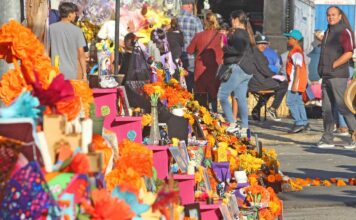Caring for a horse is no easy task. If you’re thinking of
getting one, take a look at these horse-care tips
Drive anywhere along the outskirts of the South Valley and you’re bound to find a horse. Seeing them standing there, lazily grazing in the fenced side yard of a house, makes them seem so easy to care for – almost like over-sized dogs.
But unlike dogs, cats or other domestic pets, horses are complicated creatures to care for. The staff of Tri-County Veterinary Hospital in Gilroy, and Mindy Sullivan, owner of Dreamor Ranch in San Juan Bautista, said caring for horses involves a lot of work. If someone doesn’t know how to care for a horse, it can spell disaster for the animal.
Before investing in a horse, prospective owners should talk to horse trainers and veterinarians to help them learn about properly caring for such a large animal, Sullivan said. Caring for a horse correctly can cost thousands of dollars a year.
“Make sure buying a horse is the right decision, and then it’s important to find a horse that is right for you,” she explained. “And if your child says, ‘I want a pony,’ it’s always a good idea to lease a horse before you buy a horse. Then you’ll see if your child will actually feed the horse and care for the horse and if you’re capable of keeping a horse healthy and happy. If you can’t, then you can give the horse back and no harm is done.”
To help South Valley residents understand the scope of care horses require, Sullivan and Tri-County Veterinary Hospital staff members outlined some of the essentials:
Feeding
Common problems the staff at Tri-County Veterinary Hospital see in horses are caused by owners feeding the animals incorrectly. On average, horses eat about 3 percent of their body weight.
“A horse’s diet is a complicated thing,” Sullivan said. “It’s kind of a balancing act. If you give them too much of one thing or another, they can get colic. A lot of people tend to over-feed, which is a mistake. A horse’s whole circulation system is tied in with their stomach, so when they have a stomachache, it can start affecting other things, like making their feet hot. On top of that, their diet changes with age. If you don’t know how to feed a horse, don’t guess. Ask your vet or someone else with experience.”
Farriers, Hooves
Tri-County Veterinary Hospital staff said they commonly see horses with hoof problems because owners don’t know how to care for them properly. Hiring a farrier – a person who is an expert at shoeing horses and caring for their sensitive feet – is a good idea for novices. Horses need their feet trimmed or shod every six to eight weeks.
Though most of a hoof is sturdy and durable, a rubbery, soft piece of flesh called the frog sits in the center of the hoof. Sullivan said it’s important to clean out dirt and debris from the hoof because if rocks or other small fragments get under the frog, it can cause irritation or infection.
Teeth
Horses need their teeth cleaned about once a year. If horses have problems with their teeth, they could start eating less and have stomach or nutrition problems in addition to teeth problems. A horse’s teeth grow continuously throughout its life, Sullivan said.
Manure
“A healthy horse will poop three to four times a day,” Sullivan said. “Just cleaning that up can be a full-time job, depending on how many horses you have.”
Manure shouldn’t stay wet on the ground because insects, including mosquitoes that may carry West Nile Virus, can breed in it.
Vaccines
Tri-County Veterinary Hospital staff recently treated a horse that eventually died from West Nile Virus because the owners hadn’t vaccinated the animal. Equine vaccinations include encephalitis, tetanus, rabies and strangles shots annually. Every six months, horses should also receive rhinopneumonitis and influenza shots. Every four months, they need a West Nile Virus vaccination. In addition to these vaccinations, horses need annual dental, general health and fecal exams, as well as deworming.
Mane, Tail and Coat
A horse should ideally be thoroughly groomed three to four times a week. A curry brush is used on a horse’s coat, which not only brings the dirt up to the surface, it massages the horse as well. Another brush is used in short, quick strokes to get rid of the dirt that has come to the surface. Finally, a stiff brush is used to comb out the tangles in a horse’s mane and tail. Horses don’t have nerve endings where the mane and tail meet the body, so if tangles cause pulling during combing, it doesn’t hurt, Sullivan said.
“Horses are like people in that we just feel and look better when we’re well-groomed,” she added.
Cost of Boarding
Many people who want to own a horse but don’t have the room or resources to board one may choose to pay someone to board their animal. Expect to pay anywhere from $150 to $2,000 for boarding and care.
Kelly Savio is the Lifestyles reporter for South Valley Newspapers. Contact her at (408) 842-2205 or ks****@**********rs.com.












